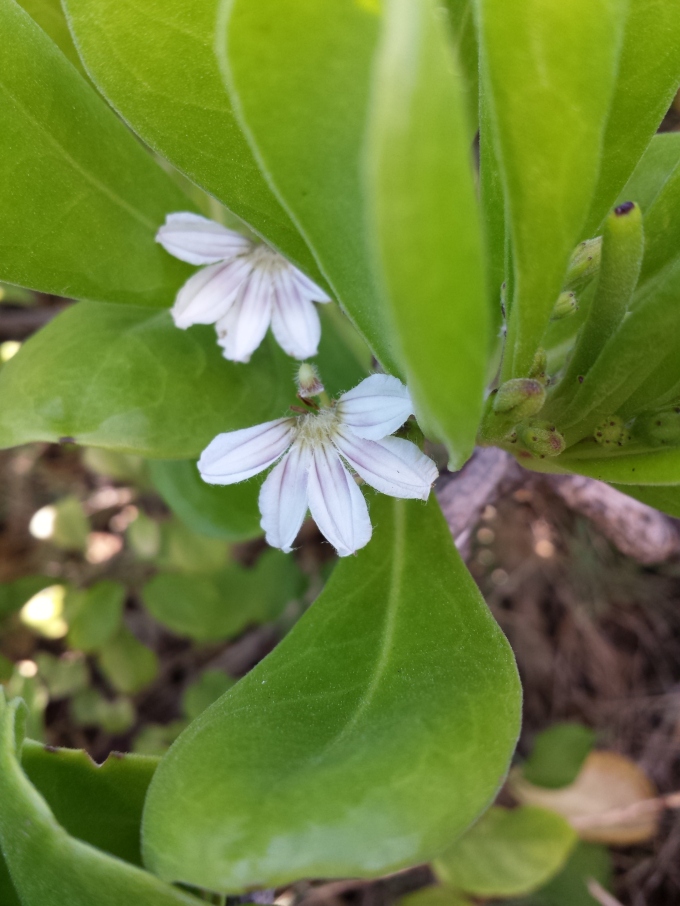This second part might more acurately be called Nani Hihiu Pua (beautiful wildflowers) because it features some of the abundant and beautiful wildflowers on Kauai that are often overlooked, but that I see frequently on my walks. Some of these plants and flower are poisonous, or have barbs and needles that can hurt, so care should be taken around them.
First is Lantana, that may be familiar to many because it grows in sunny locales all around the world. Near the ocean its growth is stunted by the tradewinds, rarely stretching greater than the height of a primrose (about 4 inches/10 cm). On upper slopes it becomes an impenetrable thicket, up to 6 feet (1.8 m) tall. It also produces small green, unripe berries [which] are poisonous and contain the toxin lantadene. Ripened berries are black, and although people have eaten them (and lived), I’d leave them for the birds.

Predominant along the shores is the lovely purple Beach Morning Glory, whereas its delicate little cousin is widely distributed all over the island.
Another common wildflower along the coastline is Beach Naupaka, the “half flower.” These are tree flowers, and the trees vary in height according to how sheltered they are—low, ground hugging rhododendron-like near the surf; reaching 15–20 feet upland. Although they are usually salt tolerant, white skeletons appear here and there at the surf’s edge. When they are in full bloom in early spring their fragrance is somewhat like maile, but when the first blossoms appear one practically has to kiss them to smell them.

Among the flowering trees, the Hau, also known as Beach Hibiscus, is most widely distributed (i.e., invasive). In the mountains, it grows just so high and then yields to its own weight, often vining along the ground and attempting to rise again occasionally. For this reason it fairly well blocks trails, and passage is only possible by constant pruning, such as the “tree tunnel” through Kealia Kai to Donkeys Beach. Most people recognize the yellow blossoms right away, but after they’ve had sex (been pollinated), they blush and fall to the ground.
The Sensitive Plant (or Shameplant) folds up its leaves when touched. However, that’s not its only defense. See the little barbs, jutting out in opposing directions along the stems? You’ll have to armor up if you wish to pluck them from your yard because they mean business. Nonetheless, their pink puffball blossoms are delightful.

Speaking of barbs, check out the Pāpipi (literally cattle fence, or pānini maoli, ‘indigenous cactus’ in Hawaiian). The cactus presumably came originally from Mexico, and is now naturalized in warm climates throughout the world. In spite of its pretty flowers it is listed as a threat to our local ecosystem. The cactus are prevalent on the drier west side of Kauai, and quite rare on the wet east side.

Yet another immigrant species is the Mexican Prickly Poppy, lovely to see but not to touch. This specimen grows in the fence row that separates Kealia Kai from the path that goes by the coast on the north end, and I saw it for the first time about a month ago.

Finally, this little flower, Mamane, is everywhere (and you might not want it to be) – it appears to love our red dirt. It follows all the prickly things because it features another reason to not touch—it’s poisonous. Only the palila (Hawiian honeycreeper) and one moth are immune to the toxicity, and the palila in particular is dependent on Mamane. Although this plant is in the pea family, it can grow in to a hardy tree when uninhibited by shore breezes and salt spray.

As with so many beautiful things Hawaiian, this plant has multiple defenses. Mamane most notably smells like creosote, so best to enjoy the beautiful bounty in the wild, and leave it be.




These flowers are breathtaking! I can only imagine how pretty they were in person.
LikeLike
Thank you. I see them almost everyday, and they still take my breath away.
LikeLiked by 1 person
What beauty to be surrounded by.
LikeLike
Thank you. That beauty is precisely what draws me, holds me here. That is, I came for the mountains and greenery and got an ocean in the bargain.
LikeLike